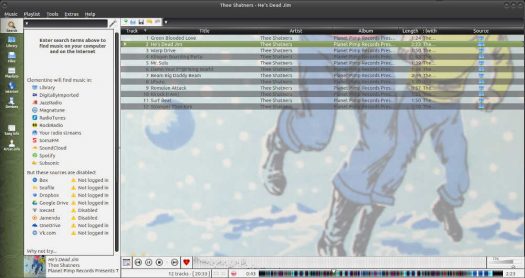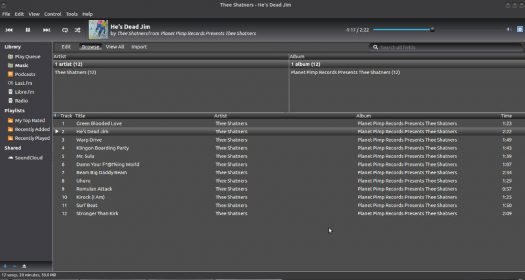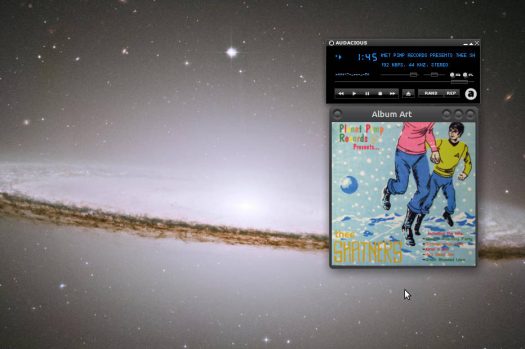In this week’s installment, our resident Linux newb goes on the prowl with one thought in mind: To find the best-of-breed FOSS music player for GNU/Linux.
The Linux Gadabout
I’ve decided to take a break from swimming upstream. Sure, I enjoy the puzzles presented by limited RAM and weird popcorn sounds that happen when caging Ubuntu MATE in a rickety Sony Vaio laptop that’s more than a decade old. I love the creative solutions the FOSS Force community shares in a concerted effort to get me back in the saddle and on my way. But I think Christine Hall summed it up best when commenting on my last column via Facebook:
“Poor Robert has been spending so much time with his hardware that he hasn’t had a chance yet to see what Linux and FOSS can do.”
She’s right. I began this journey in an attempt to refurbish a piece of obsolete machinery that had been collecting allergens in my closet for ages. In the process, I discovered that RAM purchased for less than a tank of gas in Oklahoma and the installation of some version of Linux should be able to turn it into at least a single-purpose piece of technology for the household. But perhaps an even more important discovery was that Linux — at least Ubuntu MATE — isn’t something to be scared of. I’d even go as far as to say it’s less scary and more stable than Windows circa 2016, and this is coming from someone who’s used Windows as his primary operating system since the early ’90s.
Now that that’s sorted, I’ve decided to install Ubuntu MATE on a Lenovo IdeaPad Yoga 13 with 8 GB RAM that was kindly given to me by Chris Pirillo a couple of years ago — quite the upgrade compared to what I was working with. While I’m still determined to pinpoint the cause of the weird popcorn noise that vexes my Ubuntu MATE-installed Sony Vaio (and report my findings in a future column), I’m so far really enjoying the smooth swiftness of Linux on a system that’s not on its last hinges.
At the suggestion of Matt Hartley, my first real FOSS foray is going to be a comparison of a few of the most popular open source iTunes alternatives. iTunes used to be my go-to app of choice for playing what had, by the mid-2000s, become a pretty unwieldy collection of music files ripped from CDs and transferred from cassettes and vinyl over the years. But when I discovered the magic of streaming media, I gave iTunes — and my own music collection — a break for a while.
When I had the inclination to revisit iTunes, it had changed into some unrecognizable, bloated (and it’s always been a bit of a bloat) beast. Where I had once considered it straightforward and intuitive, it was now an agent of sensory overload. It had changed for the sake of change and its new and “improved” interface left me feeling lost. I had abandoned it, and in turn, it had abandoned me right back. I suppose that’s fair.
For my purposes, the Spotify interface has been doing well enough as a music organization replacement for iTunes on my Windows machine. But now that I’m seeing what options the world of Linux presents, there’s no better time to find out if there’s anything even better.
Clementine

Click image to enlarge.
Not sure if I’m ready to call her my darling yet, but Amarok-adapted Clementine seems to have potential. I was initially excited when I saw there was Spotify integration (I’m a subscriber), but adding the recommended plugins isn’t working as of this writing. I no longer get the error message telling me to install the plugins, but Spotify songs added to a playlist simply flash as if beckoning me to an untimely demise, proceeding no further.
Aside from the disappointing omission of Spotify, I love that I can create playlists within Clementine allowing a mixture of additions from SoundCloud, Magnatune, Dropbox, Google Drive, and a sizable list of other services out there along with my own collection.
The Ghostbusters don’t always know what they’re talking about — sometimes it’s perfectly fine to cross the streams.
Rhythmbox

Click image to enlarge.
Rhythmbox installed along with Ubuntu MATE, and it seems fine enough for playing my own collection — but it crashed the first time I tried to search for songs on SoundCloud. And the second time. A third time might be the proverbial charm, but I don’t feel like pushing my luck right now. It seems to be due to a faulty plugin and not Rhythmbox itself, but no error message pops up to tell me this — it just freezes up and crashes without telling me why.
I was going to mention that a search in Rhythmbox for a specific podcast resulted in nothing, but I neglected to add a space between two of the words in the title. When I realized my error, the show I was looking for popped up right away. Still, a dialogue telling me no results were found would have been more helpful than the visual equivalent of crickets chirping.
Rhythmbox definitely subscribes to the less is more aesthetic, which I don’t think is necessarily a bad thing. It’s as no-frills as iTunes used to be (but not quite as no-frills as the Wesley Willis-inspired WinAmp).
Audacious

Click image to enlarge.
It’s funny. Just as I was reminded of WinAmp, Audacious was next on my list of iTunes alternatives to check out. If Rhythmbox is like a no-frills iTunes, Audacious is like a more-frills WinAmp. It’s cute. It doesn’t take up a lot of screen space, and it suffices for small playlists of local files.
Audacious really hearkens back to the not-so-distant age when listening to CDs directly from the CD ROM drive was about as complicated a task one would expect from audio playback software. In its simple, unassuming nature (contrary to the software’s moniker), I really found nothing to complain about. It didn’t promise anything it couldn’t deliver, and I didn’t try to make it do anything outside of its comfort zone.
Kind of a perfect relationship for the Monday morning that finds me writing this.
Playing Favorites
If I’m to pick a favorite from just these three, I suppose it’s going to be Clementine. Sure, it might be a bit more resource intensive than the other choices and a little broken in places, but I still prefer it to what iTunes has become. As far as the differences between trying new software in a Windows versus a Linux environment, I’m not going to lie: finding my way around Linux is taking some getting used to. And that’s okay — I expected as much. Just as I’d expect trying to haggle in Portuguese might be a bit rough at first if I’m just learning the language and I’ve only known English until now.
Luckily, Christine Hall has been kind enough to pass along what look to be excellent resources for furthering my competence with Portuguese…er…Linux; I hope to attack my next column’s project with a little more insight. If all goes well, I might even be able to listen to a mix of my favorite streaming music services and local files in a Clementine playlist while I’m doing it! My fingers are crossed and I remain undaunted.
“Bob” Fogarty was the editor-in-chief at Chris Pirillo’s LockerGnome.com for nearly 12 years, and has written for ReadWrite.com and TheArtofCharm.com. He lives in San Diego with his wife and a medium-sized menagerie of beasties great and small. Follow him on Twitter: @Fogarty









Nice to see you poking around different applications. I highly recommend doing that. I will sometimes stumble across some gem that I never knew about and wonder how I had never discovered it before.
Getting used to Linux can be difficult when you get past the basics but start missing well-known applications from the Mac or Windows worlds. For most things there is usually an enjoyable, or in a few cases: at least workable, solution. Typically there are several.
I don’t understand why this article is titled “looking for an iTunes alternative for Linux”. Are we still looking at Apple and it’s products as the go-to brand for setting the bar ?
When will this “Alternative” trend will end ? Linux as a Windows alternative, LibreOffice for MS office, Gimp for Photoshop… Just call it as it is: Looking for the best music player/manager for Linux (that can work on an old machine).
You might want to have a look at Banshee. I don’t listen to radio, online or otherwise, anymore except for NPR, but I’ve found it to be good for podcasts and for listening to music from my private collection. Your experience may vary. 🙂
A relatively new Linux user here, coming from 12 years full time on OS X. Used varying distros in VMs over the last year playing around and learning before making a recent switch. While much of the software that I have used I could find replacements for (1Password to Lastpass) or things were just cross platform (Steam; youtube-dl), iTunes was one of the things that I was concerned about. While I don’t buy music much anymore, I do have a sizeable music collection (and other media from iTunes – movies and TV Shows). So far, Clementine seems to be the best way I have found to play that media.
If you’re feeling a bit more adventurous, I’d definitely give Tomahawk a look! https://www.tomahawk-player.org/
Spotify, SoundCloud, Youtube, and many others are supported.
But none of these actually allow you to access your itunes account. This is one of those programs that I just wish would be released for linux, just as it has been released for Windows. Not that I like it – I hate it – but its absence from Linux is surely a big roadblock to those coming from the Mac world…
Got into linux right after kde3 died so I did not have amarok 1.4 as a reference but as soon as I found clementine(shortly after it came out) I have been using it ever since. On windows and linux. What I like is that it still works like many of the players I used back in the 90’s and is super simple to play straight from mp3 files on a whim which is still my outdated but preferred method(I catalog my own music via artist and albumn by folders….never did like the modern/itunes method of a music database).
Great review of some options.
It’s humorous to me because I left OSX 10+ years ago BECAUSE of iTunes and how hideous it was. I didn’t like the way Apple forced you to use iTunes to manage your iPod–I found Rockbox, put it on the iPod, and tasted FOSS freedom. Linux came right after.
I’ll add VLC to the list as a great and flexible player.
I also found Clementine shortly after switching from Windows 7 to Mint 17.3 at the end of 12/2015.
I doubt I’ll switch, but I will take a look at the others listed here.
@simon gray Can you not run iTunes via WINE? If I didn’t hate Apple (and iTunes) so much I’d check myself. If not, you could run Windows in a Virtualbox and use that version.
Tomahawk, mentioned and linked above, says it has iTunes support…
I don’t use a music player app, as such, I mostly just use my file manager to locate tunes in my pretty extensive music collection, and either play individual songs in VLC, or use the VLC play directory function to play and entire CD or 2s worth of music.
While I’ve tried on line music streaming via the usual suspects, already mentioned, I find it tends to be a bit unreliable, due to Australia’s crappy Internet, especially out here in the bush.
Mind you they have shown they do care about the bush a lot, they’ve named the new satellite Internet “Sky Muster” … do you see what they did there? I t makes us country folk feel so good.
It’s not open source, but if you’re already using Spotify there is a Spotify client you can use. It works pretty well, but does lag behind in updates verses Windows and OS X.
There’s also always VLC, although it may or may not meet all your needs as a music library tool.
Follow up comment: I should have read the article more carefully. Of course Spotify proper will not work if you’re looking for a FOSS player.
Unfortunately I haven’t had too much success with Spotify integration in any FOSS software. Clementine is the closest, but it doesn’t really work well most of the time.
I recommend Silverjuke, Tomahawk and JRiver Media Player. Silverjuke and Tomahawk have a very nice UI, and JRiver is, probably, the best music player in Linux – it has some very nice sound enhancers.
I use youtube-dl and simply download videos as music files. Toss in CMUS and it’s all the free music I can shake a stick at.
I wouldn’t even use iTunes as a guideline for a music player. Never liked the UI of whyTunes, the only reason I ever installed it (inside a MSWin7 test VM) was to use a $50 gift card I was given for my birthday. 18 or more months later, I still have five dollars credit on it. I end up getting most of my music downloads from NicoNico and Piapro these days anyway. That and digitizing my large collection of vinyl.
I suppose I may as well throw in my two cents, though I doubt it’s that relevant to what Robert wants in a music player.
I tend to play music a few different ways, depending on the situation.
If I’m sitting around a table, just playing random songs of my choosing or people’s request, I tend to use Audacious or DeaDBeeF from the file manager (unless I’m using my OpenPandora, but that’s another topic) supplemented by SMTube for playing things I don’t have in my collection of ogg, flac, and mp3 files (mostly ripped from CDs).
If I want to let the player do the work of choosing the next song, I generally use either GMusicBrowser or Quod Libet.
If I’m playing the music at a party, I tend to use Mixxx (sometimes I switch over to another player to automate things for a while), and sometimes I use SMTube again if Internet access is available (definitely not always the case).
I don’t do a lot of streaming, and I pretty much never let a program pick random streams even within a certain category. I’m probably not your typical user, even though I listen to music quite a bit.
Mike: Thanks for the encouragement! The more I learn about FOSS, the less reliant I feel on Windows. It’s a good feeling.
Argoson: It’s titled that way because it’s accurate: I’m looking for an alternative to something I’m familiar with — that something happens to be iTunes. I don’t think I claimed it as setting the bar for anything; if I thought it was so bar-setting and go-to, I wouldn’t be looking for an alternative at all!
But speaking to the “alternative” trend: A lot of people come from Windows and OS X backgrounds to see if the grass really is greener on the FOSS side of the fence. We don’t always know what we want, so we proceed from some point of familiarity. Along the way, we may find something that gets the job done with an interface that doesn’t recall what we went looking for in the first place.
Christine Hall: I’ll give it a shot (and I also dig the name)!
Thanks for the feedback, Jon! I like it (aside from the problems mentioned), but I’ve also been checking out Tomahawk as Blue Mint Linux, James, and Liviu have mentioned in this thread and I’m enjoying it. Not sure which one I’d pick as a favorite just yet, though!
Blue Mint Linux: I’m giving Tomahawk a test run now. I like it so far!
simon gray: It would be nice if we had the option, but I’m also not going to hold my breath. Besides, if it were that easy, I might have just settled for the familiar instead of trying to find a reasonable — and perhaps better — FOSS alternative.
markh: That’s how I like to catalog my music files, too. Probably comes from my nostalgia for record collecting (which I still do, but on a much smaller scale than I once did).
scotty: Oh, right! VLC! I really need to remember to give that a fair shake.
Michael: As sludgy as iTunes is in Windows, I shudder to think what running it in Wine would be like! But now my curiosity’s been aroused because I seem to be a glutton for punishment…
James: Indeed, it does!
tracyanne: Yikes. In your situation, I’d probably dust off my vinyl records — and cassettes — more often!
Ryan K: I don’t have a problem with using Spotify proper, but I was hoping to find something that would allow me to mix and match music from different services in my own playlists. Like Clementine, Tomahawk should allow me to do this — and seemed to at first — but it’s been rebelling today.
Liviu: JRiver and Silverjuke? I’ll add ’em to my list to try. Thanks!
Joe: That sounds like a lot of work!
jelabarre59: I wouldn’t use iTunes as a guideline for a music player, either — it’s why I started looking for an alternative!
CFWhitman: That’s a good list! The way I usually listen to music is via deliberate playlists I’ve made in Spotify, but I’ll sometimes get the urge to hear new music and switch it to an artist-defined “radio” stream in Spotify or Pandora. I would really like to be able to seamlessly mix in songs from SoundCloud and my own files — maybe someday!
Robert Glen Fogarty
July 28, 2016 at 9:59 pm
Robert my entire Music collection now resides on my server (about 300GB of mp3, ogg and wav files and mp4 videos), as does my movie collection, and my ebook collection. I just can’t be bothered with a dedicated player like Banshee and Audacious, and etc. VLC plus the filemanager works just fine for me.
When we travel I can load the server into our motorhome and listen to almost any sort of music we choose… except country… I can live without country music.
The server has 2 sets of 4TB hdds configured as RAID 1, so I’ve got 8TByte.
tracyanne: From what I’ve been reading, VLC seems like a popular catch-all for native media files — and perfect for your portable needs. I’d have to give it a test run with an integration of streaming media to see if it would work for my needs.
On a recent cross-country road trip, I did happen across a few lonely places where I simply couldn’t get a signal for streaming; maybe taking your example and bringing along a portable drive might serve me better next time.
I don’t have a device (Apple or other) that needs iTunes syncing, however I’ve been researching how to download selected individual podcasts from there. Unfortunately some clueless folks insist on ONLY posting on iTunes.
I just discovered a package named tunesviewer that will let you do just that. UI is a little clunky but it does the job. Once downloaded, I burn the tracks onto CD/RW for use in my automobile player that doesn’t read flash drives.